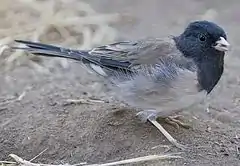| Junco[1] | |||
| Wagler, 1831[2] | |||
 Przedstawiciel rodzaju – junko zwyczajny (J. hyemalis) | |||
| Systematyka | |||
| Domena | |||
|---|---|---|---|
| Królestwo | |||
| Typ | |||
| Podtyp | |||
| Gromada | |||
| Podgromada | |||
| Infragromada | |||
| Rząd | |||
| Podrząd | |||
| Rodzina | |||
| Rodzaj |
Junco | ||
| Typ nomenklatoryczny | |||
|
Junco phaeonotus Wagler, 1831 | |||
| Gatunki | |||
| |||
Zasięg występowania
Rodzaj obejmuje gatunki występujące w Ameryce Północnej (włącznie z Centralną)[3].
Morfologia
Długość ciała 13–17,2 cm, masa ciała 14,3–28 g[4].
Systematyka
Etymologia
Junco: średniowiecznołac. junco – potrzos zwyczajny, od iuncus – trzcina[5].
Podział systematyczny
Do rodzaju należą następujące gatunki[6]:
- Junco vulcani – junko ciemnosterny
- Junco bairdi – junko złotooki – takson wyodrębniony ostatnio z J. phaeonotus[7][8]
- Junco insularis – junko wyspowy – takson wyodrębniony ostatnio z J. hyemalis[9][10][11], zmiana zaakceptowana przez AOU[12]
- Junco alticola – junko gwatemalski – takson wyodrębniony ostatnio z J. phaeonotus[7][8]
- Junco phaeonotus – junko górski
- Junco hyemalis – junko zwyczajny
Przypisy
- ↑ Junco, [w:] Integrated Taxonomic Information System (ang.).
- ↑ J.G. Wagler. Einige Mittheilungen über Thiere Mexicos. „Isis von Oken”. 24, s. kol. 526, 1831. (niem.).
- ↑ F. Gill, D. Donsker & P. Rasmussen (red.): New World Sparrows, Bush Tanagers. IOC World Bird List (v11.1). [dostęp 2021-02-09]. (ang.).
- ↑ J. Rising, A. Jaramillo, J.L. Copete, S. Madge & P. Ryan: Family Emberizidae (Buntings and New World Sparrows). W: J. del Hoyo, A. Elliott & D.A. Christie: Handbook of the Birds of the World. Cz. 16: Tanagers to New World Blackbirds. Barcelona: Lynx Edicions, 2011, s. 541–542. ISBN 978-84-96553-78-1. (ang.).
- ↑ Junco, [w:] The Key to Scientific Names, J.A. Jobling (red.), [w:] Birds of the World, S.M. Billerman et al. (red.), Cornell Lab of Ornithology, Ithaca [dostęp 2022-02-17] (ang.), [archiwum].
- ↑ Systematyka i nazwy polskie za: P. Mielczarek & M. Kuziemko: Rodzina: Passerellidae Cabanis & Heine, 1850-51 - pasówki - New world sparrows and allies (wersja: 2021-01-20). [w:] Kompletna lista ptaków świata [on-line]. Instytut Nauk o Środowisku Uniwersytetu Jagiellońskiego. [dostęp 2021-02-09].
- 1 2 B. Milá, P. Aleixandre, S. Alvarez-Nordström & J. McCormack: More than meets the eye: lineage diversity and evolutionary history of Dark-eyed and Yellow-eyed Juncos. W: E.D. Ketterson & J.W. Atwell (red): Snowbird: Integrative biology and evolutionary diversity in the junco. Chicago: Chicago University Press, 2016, s. 179–198. ISBN 978-0-226-33080-8. (ang.).
- 1 2 G. Friis, P. Aleixandre, R. Rodríguez-Estrella, A.G. Navarro-Sigüenza & B. Milá. Rapid postglacial diversification and long-term stasis within the songbird genus Junco: phylogeographic and phylogenomic evidence. „Molecular Ecology”. 25 (24), s. 6175–6195, 2016. DOI: 10.1111/mec.13911. (ang.).
- ↑ Ch.G. Sibley & B.L. Monroe Jr.: Distribution and Taxonomy of the Birds of the World. New Haven: Yale University Press, 1990. ISBN 0-300-04969-2.
- ↑ P. Aleixandre, J.H. Montoya & B. Milá. Speciation on oceanic islands: Rapid adaptive divergence vs. cryptic speciation in a Guadalupe Island songbird (Aves: Junco). „PLoS One”. 8 (5), s. e63242, 1–12, 2013. DOI: 10.1371/journal.pone.0063242. (ang.).
- ↑ J. Klicka, F.K. Barker, K.J. Burns, S.M. Lanyon, I.J. Lovette, J.A. Chaves & R.W. Bryson Jr.. A comprehensive multilocus assessment of sparrow (Aves: Passerellidae) relationships. „Molecular Phylogenetics and Evolution”. 77, s. 177–182, 2014. DOI: 10.1016/j.ympev.2014.04.025. (ang.).
- ↑ R.T. Chesser, R.C. Banks, K.J. Burns, C. Cicero, J.L. Dunn, A.W. Kratter, I.J. Lovette, A.G. Navarro-Sigüenza, P.C. Rasmussen, J.V. Remsen Jr., J.D. Rising, D.F. Stotz & K. Winker. Fifty-sixth Supplement to the American Ornithologists' Union: Check-list of North American Birds. „The Auk”. 132 (3), s. 748–764, 2015. DOI: 10.1642/AUK-15-73.1. (ang.).
This article is issued from Wikipedia. The text is licensed under Creative Commons - Attribution - Sharealike. Additional terms may apply for the media files.